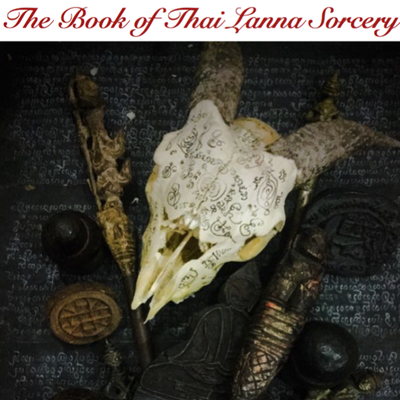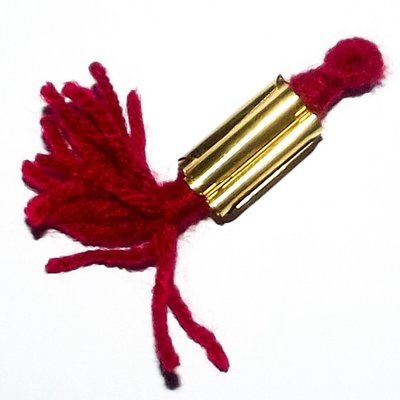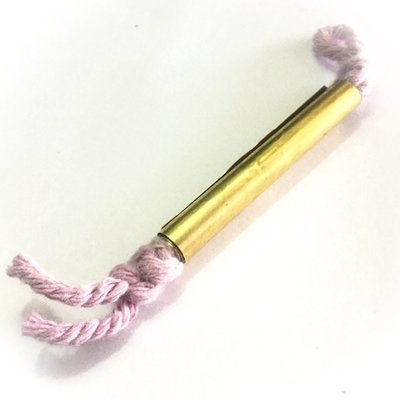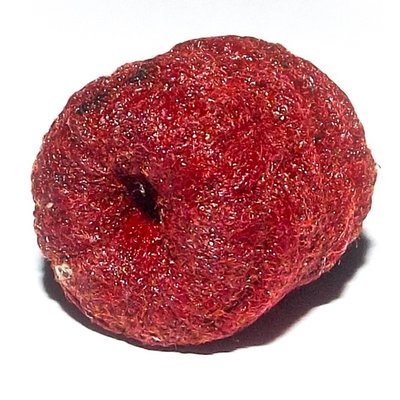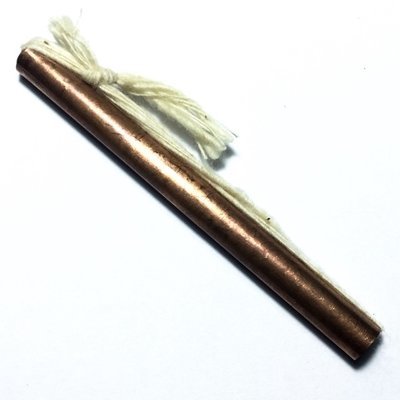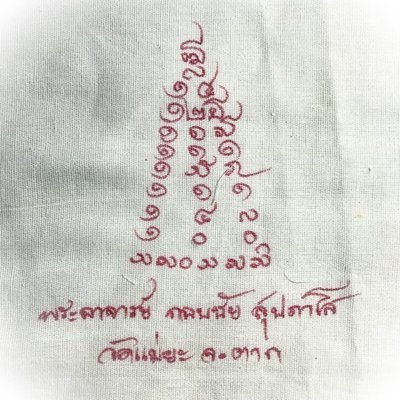

Thailand Amulets
Thai Buddhist and Magical amulets for Wealth, Health, Love and Happiness.
Vast Selection of Amulets
We have a vast selection of over 4000 different kinds of Sacred Amulets and Bucha Items, including Buddha Image, Loi Ongk statuettes, Buddhist Monk Coin Amulets, Takrut Charms, Nam Man Prai Oils, Mai Kroo Wands, Mitmor Ritual Knife, Lek Lai Kaya Siddhi Elemental Substance, Kumarn Tong, Gambling Amulets, Mae Nang Prai, Muan Sarn Sacred Powder Amulets, Palad Khik, Animist Charms, Necromantic Amulets, Buddhist, Animist, Brahman and Necromantic Amulets.
Ngu Kin Haang (Buang Nak ) Serpent Eating Its Tail Nuea Kala Ta Diaw - Pra Ajarn Gorp Chai - Wat Mae Ya
Hand carved from Kala Ta Diaw (one eyed coconut shell), in the image of a coiled snake swallowing its own tail, the Ngu Kin Hang is an Ancient Amulet of the Thai Lanna Sorcery tradition.
The Ngu Kin Haang, also often called 'Buang Nakabat' (Magic Naga Ring), is an image of a serpent or Naga swallowing its tail. Much like the Oroubouros serpent of Hermetic Magick, the attributed meanings are manyfold.
The Ngu Kin Haang is made from one eyed coconut shell, and has been carved into the image of the Ngu Kin Haang. One eyed coconut is a Magical item in its own right, which is said to possess immense Maha Ud, Maha Pokasap and Kong Grapan Chadtri powers within it's substance.
Each individual amulet is of course slightly different, due to hand carved artisanry, and also due to the surface colors and patterns of the Kala Ta Diaw one eyed coconut shell, are varied according to how Mother nature makes them.
This is especially noticeable also on the rear faces, where each individual amulet has its own distinct pattern of light and dark. Hence, the amulet you recieve may have a slightly different pattern on it than the one seen in the pictures in this article.
The rear side of each amulet is empowered with sacred Lanna Agkhara spell inscriptions. In the Lanna region, the amulet is more often called 'Buang Nakabat' and can be found in the legends of Manorah, where the Pran Bun hunter asked Phu Sri Sutto Nakarach, the Naga King of Bodhala, to borrow his magic ring.
Above image; Pran Bun Hunter, With Buang Nakabat Catches Manorah
The Naga King was scared that the Pran Bun hunter would not return the ring, but he risked it and gave it to the Pran Bun, on the condition that he would return it. The Naga King also explained that it would fulfill all of his wishes and make whatever happen that he wished, however large or small the wish. The Pran Bun Hunter was thus able to catch more than his fill of game, and then used the Buang Nakabat as a sling and rope to capture the Manorah Kinaree Goddess, and returned the ring to the Naga King thereafter.
The Buang Nakabat is for the Lanna People, primarily a Maha Pokasap 'Kin Mai Roo Sin' (eat drink, live and be merry without limits) type 'Krueang Rang' (Occult Talisman), with Metta Mahaniyom Kaa Khaay Mercy Charm for Prosperity and Good Business.
On can find or attribute many possible meanings to the symbolism contained within the image of a serpent eating its own tail, especially since this form of imagery has been found present within the pantheon of Sacred Art and Imagery of many different cultures around the world, be it the Mayans and Inca, the Druids and Pagans, the Hindu and Buddhists, or the Middle Eastern rooted Hermetic Traditions.
Snakes are sacred in many West African religions. The demi-god Aidophedo uses the image of a serpent biting its own tail. The Ouroboros is also seen in Fon or Dahomean iconography, as well as in Yoruba imagery as Oshunmare in W. Africa.
Even the Norse Legends have the image of the snake eating its own tail.
It is the power of the Human Mind and its ability to attribute corresponding meanings to imagery through symbolic attribution, which is the foundation of the activation of a Magical Mind, and its subsequent empowerment.
The Ngu Kin Haang of the Lanna Folk is Maha Pokasap through 'Maha Ud Sap' enclosure, or containment of accumulated wealth and treasures. it also insinuates impermeability, and hence Maha Ud Gunstopper and Kong Grapan Chadtri Invincibility against all forms of Penetrative Weaponry and Ammunition.
The Ngu (snake) and the Naga Serpent, are both given the attributed meaning of Metta Mahaniyom Mercy Charm, leaning towards successful business sales, and easy ascension through the ranks of promotion.
- Ngu Snake is more Maha Pokasap (Treasure Accumulation) and Maha Sanaeh (Seduction Power).
- Naga is more Maha Amnaj (Commanding Power over others), and Serm Yos (Increase Status and Rank).
It depends hence whether you wish to pray to the amulet as a Ngu (snake) or a Naga (Bhodala Serpent King), as to how you approach the method of Bucha, and what kind of Magic you Summon and Invoke from it.
The Buang Nak/Ngu Kin Hang Animist Talisman is a very ancient Wicha of the Northern Lanna people, which is not seen very often in the present day, for which this is a 'Serp Dtamnan' amulet, which meritoriously preserves an ancient sorcery formula, and protects the Wicha from becoming lost to Human memory. Below; example of a traditional Lanna style Buang Nakabat talisman.
The words 'Serp San Dtamnan Yant Lanna', mean that this is an ancient amulet that is in danger of being lost to the modern era, and through its making and renewed explanation of its meanings, is not only a Magical Amulet of Ancient Times and Great Power, but that its making in the present Era, is an act of preservation of Ancient Thai Lanna Occultism.
This is because the Buang Nak/Ngu Kin Haang, is hardly seen these days, and very few Masters of the present day possess the Wicha, or even know of its existence.
Pra Ajarn Gorp Chai has thus not only brought is an authentic Ancient Sorcery Spell of the Naga Kings, but has preserved the Wicha for many future Generations, by reviving true knowledge of its existence, uses and meanings, and methods of making, for the preservation of this truly inimitable spell of the Lanna Magical Arts.
Although the amulet is empowered with the Invocations of the Naga Kings and the Wicha Ngu Kin Haang Maha Pokasap, and Wicha Maha Ud, the amulet can still be used to attribute your own understanding of the meanings contained within the amulet, to be compatible with those attributed to the God Oroubouros.
If Seen as As Oroubouros;
The Ouroboros is an ancient symbol depicting a serpent or dragon eating its own tail. The name originates from within Greek language; (oura) meaning "tail" and (boros) meaning "eating", thus "he who eats the tail". The Ouroboros represents the perpetual cyclic renewal of life and infinity, the concept of eternity and the eternal return, and represents the cycle of life, death and rebirth, leading to immortality, as in the Phoenix.
The current mathematical symbol for infinity - may be derived from a variant on the classic Ouroboros with the snake looped once before eating its own tail, and such depictions of the double loop as a snake eating its own tail are common today in fantasy art and fantasy literature, though other conjectures also exist.
It can also represent the idea of primordial unity related to something existing in or persisting before any beginning with such force or qualities it cannot be extinguished. The ouroboros has been important in religious and mythological symbolism, but has also been frequently used in alchemical illustrations, where it symbolizes the circular nature of the alchemist's opus.
It is also often associated with Gnosticism and Hermeticism. Showing itself primarily in ancient Gnostic texts, the Ouroboros is any image of a snake, worm, serpent, or dragon biting its own tail. Generally taking on a circular form, the symbol is representative of many broad concepts.
Time, life continuity, completion, the repetition of history, the self-sufficiency of nature, and the rebirth of the Earth can all be seen within the circular boundaries of the Ouroboros. Cultures from around the world through history, have shaped the symbol of the serpent eating its own tail, to fit their own beliefs and purposes.
The image has been seen in ancient Egypt, Japan, India, Thailand, Indonesia, in Greek alchemic texts, Druidic and Celtic Sacred Art, European woodcuts, Native American Indian tribes, and by the Aztecs and Maya.
It has, at times, been directly associated to such varying symbols as the Roman god Janus, the Chinese Ying Yang, and the Biblical serpent in the Garden of Eden. The Ouroboros is believed to have been inspired by the Milky Way.
If Seen as Payanak - the Bodhala Naga King
The 'Payanak', or Naga, is a Very powerful Magical Entity and a Deity of the Thai Buddhist Pantheon. the Naga Kings are devotees of the Lord Buddha, and Protectors of the Dhamma.The Naga is an extremely powerful and powerful spirit being of the Bodhala Underworld, and is a Deva, who possesses Shapeshifter abilities, and can transform into Human Form at will
Kata Bucha Phu Sri Sutto Nakarach
Always Chant the Maha Namasakara (Namo Tassa) 3 times before Chanting to Buddhist Amulets.
Namō Dtassa Pakawadtō Arahadtō Sammā Samputtassa
Namō Dtassa Pakawadtō Arahadtō Sammā Samputtassa
Namō Dtassa Pakawadtō Arahadtō Sammā Samputtassa
Then Chant;
Aehi Sangkang Bpiyo Naaka Subannaanang
Mayang Gaaya Waaja Jidt-Dtang Ahang Wantaa Jao Phu Payaa Naakaatibodii Srii Sutto Naakaraach Wisutti Taewaa Bpuuchaemi
Tudtiyambpi GaayaWaaja Jidt-Dtang Ahang Wantaa Jao Phu Payaa Naakaatibodii Srii Sutto Naakaraach Wisutti Taewaa Bpuuchaemi
Dtadtiyambpi Gaaya Waaja Jidt-Dtang Ahang Wantaa Jao Phu Payaa Naakaatibodii Srii Sutto Naakaraach Wisutti Taewaa Bpuuchaemi
Ayang Mahaa Naako Itti mandti Tudtimandto Imichaegaalaena Mahaa Naakang Bpuuchaemi
(Chant 3 Times).
Kata Bucha Paya Nak
The Naga is a Very powerful Magical Entity and a Deity of the Thai Buddhist Pantheon. the Naga Kings are devotees of the Lord Buddha, and Protectors of the Dhamma.
Na Dti Dtang Payaama Naakaaya Apinang Naakaa Saatuno Pandtae Ya Ma Ya Ma
Kata Anchern Paya Nak
(to Invite the Naga King to Come and be present)
Namaami Lila Saakhae Badt-Tha La Bpa Tammae Sa Ka Lab Dtii Sayae Dtaa Naaka Laa Chaena Yabpi Sadto
Kata Saggaara Bucha Paya Nak
(Kata for giving offerings to the Naga Deity)
Aehi Sangkang Bpiyo Naaka Subannaanang Mayang
Specific Kata
If you wish to pray to particular Deities of the Naga Variety, you can do so with the following Kata;
Gaaya Waaja Jidt Dtang Ahang Wantaa
(Then Use the Name of your Chosen Naga Deity here, e.g. ‘Waasugrii Naakaraach’ “Anandta Naakaraach’ ‘ Naakiaatibodee Sri Sutto’ etc), and continue with;
Wisutti Taewaa Buchaemi
In the case of let us say, Phu Ruesi Naakaraach Deity, the Kata would go like this;
Gaaya Waaja Jidt Dtang Ahang Wantaa Phu Rasi Nakarach Wisutti Taewaa Buchaemi
Kata Bucha Paya Nak (Alternative Version)
Naaka Taewa Brii Dtaa Pawan Dtiha Kaandtimaa Bpanondti Waena Wiipii Samsaandti Loga Maa Saatya Motadtae Saasadticha Smaacha
Abbreviated Form
Kad Sa Ma U Ma (Chant 9 Times).
The Ngu Kin Haang has been carved by hand by Pra Ajarn Gorp Chai himself, performing incantations throughout their making, finally inscribing sacred Lanna Agkhara spells onto the rear face, and then a final empowerment and awakening through the final Tewapisek (Deva Abhiseka) Ritual.
We pray that Pra Ajarn Gorp Chai continues to present us with these highly limited editions of sacred Northern Lanna Wicha Amulets. The amulets of Pra Ajarn Gorp Chai are all empowered and constructed completely himself, without any machinery, assistance from Looksit, or mass made methods of production.
He preserves the ancient methods, as in olden days, as the Lanna Masters would make the amulets with their own hand, and not with the assistance of factory made components or modern machinery.
Nor did the Ancient Masters have to accept to bless amulets which were mass made, and donated for blessing, rather, used their own precious time and efforts and Meditations to create and empower each amulet one after the other, passing through the hands and incantations of the Master one by one.
These days, it is truly difficult to find a Master who still uses this old-school method of personal applied Wicha and without assistance from third parties. We can but recommend the amulets of Pra Ajarn Gorp Chai most highly for this reason.
Pra Ajarn Gorp Chai is a lineage master of Wat Mae Ya, following in the tradition of his Kroo Ba Ajarn, Luang Phu Thin (Current Abbot) and the Great Luang Phu Kroo Ba Ban, Wat Mae Ya is the temple of the Late and Great Arya Sangha (said by his devotees to have attained Arahantship) 'Luang Phu Ban'.
Pra Ajarn Gorp Chai is continuing the Wicha and Traditional Amulet making of the Great Kroo Ba Ajarn; Luang Phu Kroo Ba Ban, the ex Abbot of Wat Mae Ya temple. He is proficient in the Wicha of Lanna Amulet making and in addition, a Master of Kata Akom and Agkhara Lanna Magical Script, and Sak Yant Thai Temple Tattoos.
Pra Ajarn Gorp Chai has put many hours of work into carving, inscribing and spellbinding each single amulet with his own hand, with constant empowerment through incantation and willful meditative intent, These amulets are made with exactly the same hand made applied methods as used by the ancient Lanna Folk.
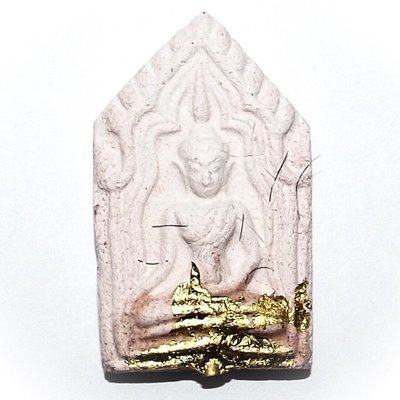

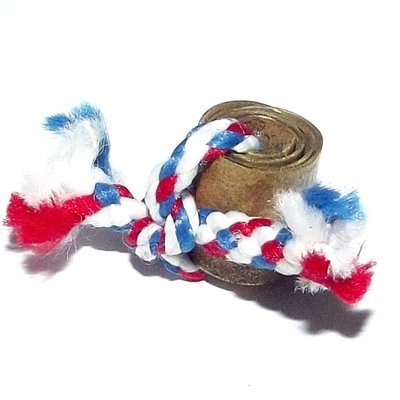

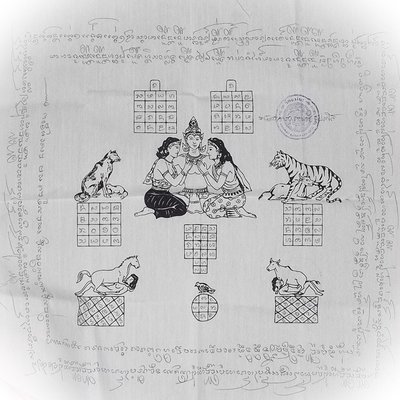
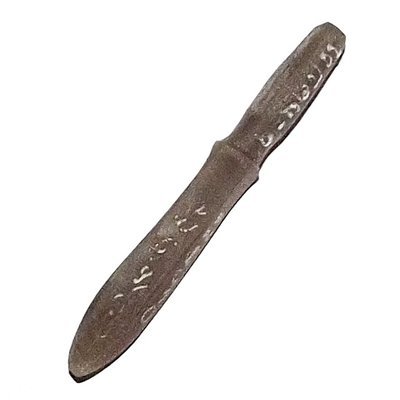
Contact Us
Follow Us on Youtube
About Us
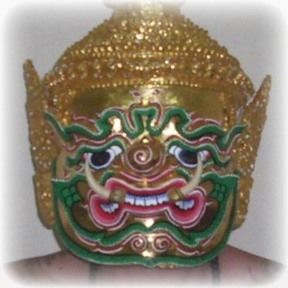
Ajarn Spencer
Proprietor
Thailand Amulets is owned and Administrated by Thai Occult and Amulet expert, Ajarn Spencer Littlewood who guarantees only authentic blessed amulets, and a free gift with every order, as well as his safe delivery or money back guarantee. https://facebook.com/ajarnspencer





























